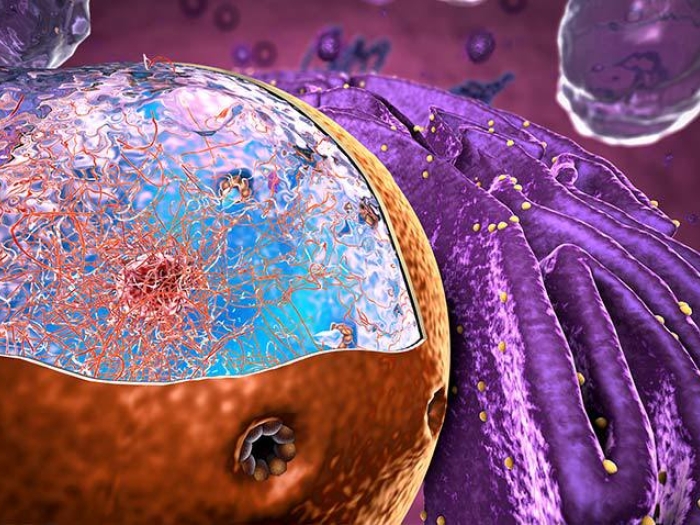Roughly 1 in 50 promising cancer drug candidates makes it to market. What’s holding the other 49 back?
7:00 AM
Author |

Virtually every day, scientists are identifying potential new drugs to tackle the next pathway or mutation that's fueling cancer. But only a small fraction of those make it to a clinical trial. And among those that do, more than half fail because the drug didn't work.
MORE FROM THE LAB: Sign up for our weekly newsletter
"The statistics are rather bleak in terms of attrition of drug trials," says Judith Sebolt-Leopold, Ph.D., co-director of the developmental therapeutics program at the University of Michigan Rogel Cancer Center. "And the failure rate is higher in oncology than in other diseases."
Many clinical trials use progression-free survival as the endpoint. In other words, from the time treatment is initiated, how long before the patient on the drug shows signs of the disease getting worse?
But is this the best measure? Ultimately, many oncology trials fail because they do not show a treatment extends survival in a meaningful way.
For example, a drug tested in ocular melanoma, a rare cancer occurring in the eye, resulted in an eight-week improvement in progression-free survival. The study showed no difference in overall survival. But this was deemed such a success that one researcher touted it as "practice-changing" at an annual cancer research meeting.
There are numerous failed, but nonetheless promising, drug candidates sitting on the shelf because we didn't design the right clinical trial for them.Judith Sebolt-Leopold, Ph.D.
Targeting the right combination
Sometimes the path to drug approval diverges from the original clinical trial plans. While the drug may be designed to target one gene, it proves more useful in another way. Take sorafenib, which was originally developed based on its ability to inhibit the gene BRAF. But clinical trials in melanoma, where BRAF is frequently mutated, didn't show improvements in survival.
Instead, sorafenib, which targets multiple signaling molecules besides BRAF, proved effective in inhibiting VEGF, a signaling pathway that controls the growth of blood vessels. Sorafenib is now FDA-approved for kidney, liver and thyroid cancer.
How treatments are combined matters, too.
Christopher Lao, M.D., MPH, recounts a patient with metastatic melanoma who enrolled in a clinical trial testing a BRAF inhibitor. Initially, the patient's tumors practically disappeared. But soon, the patient became resistant to the inhibitor and the cancer flared back to life.
SEE ALSO: How Genomic Sequencing May Be Widening Racial Disparities in Cancer Care
"Unfortunately, patients can develop resistance to these inhibitors. They could go from having a dramatic response to suddenly having rapid growth," says Lao, director of the clinical trials support unit at the U-M Rogel Cancer Center.
The next step was to combine the BRAF inhibitor with an inhibitor of the pathway MEK, based on laboratory findings. This yielded greater success. "It was more potent, more patients responded and they had a longer response," Lao says. Overall survival for advanced melanoma increased by more than six months with this combination.
Having robust laboratory data and developing better mouse models are crucial steps, Sebolt-Leopold says. These preclinical models can help predict the likelihood of success. They might reveal when or why tumors are likely to become resistant to the treatment, or suggest the possibility of combining the new drug with one or more existing therapies to produce a better response. This data can also help determine which patients might benefit most, based on specific biomarkers. The ability to select only patients with a high likelihood of responding could dramatically increase success rates in cancer drug development.
Sebolt-Leopold recounts her pharmaceutical company experience when new drug candidates were tested across a broad range of cancers for fear of missing potentially responsive patient populations. One drug in particular was designed specifically to target cancers with mutations in the RAS or RAF genes. Laboratory research suggested the drug would be effective only in this group.
Not surprisingly, the clinical trial, which included patients with and without these mutations, failed. Because of the large number of patients overall who didn't respond, the subgroup of patients researchers predicted would respond was diluted. It was difficult to judge the drug's effectiveness.
"There are numerous failed, but nonetheless promising, drug candidates sitting on the shelf because we didn't design the right clinical trial for them," Sebolt-Leopold says.
Success — and caution
Overall, there's been success. In advanced melanoma, median survival just six years ago was as little as six months. Today, median survival is more than 30 months, and many patients are living a number of years with the disease. There are roughly 30 small-molecule kinase inhibitors approved across a variety of cancer types.
"That may sound great, but they do not always have a huge impact. In most cases we see a one- to three-month advantage in survival. We clearly don't know how to apply all these drugs in the clinic," Sebolt-Leopold says.
Researchers suggest the need for a smarter approach to testing new drug compounds, one that focuses on substantial improvements in patient survival.
"We need to determine how to use these new targeted therapies together, create the right sequence to avoid resistance and develop combinations of two or even three different drugs to tackle the cancer together," Lao says.

Explore a variety of healthcare news & stories by visiting the Health Lab home page for more articles.

Department of Communication at Michigan Medicine
Want top health & research news weekly? Sign up for Health Lab’s newsletters today!





